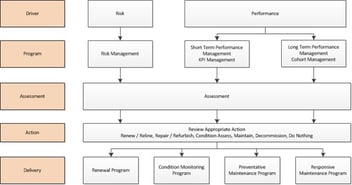Here’s how water utilities can use condition assessment to make better decisions
Assessing the condition of assets is integral to effective maintenance and operations planning for all water utilities, but there are always areas to improve.
According to SUEZ Water Asset Manager Zoubir Ait Mansour, there is an opportunity to leverage assessments to provide more comprehensive insight into asset risks and opportunities.
Ait Mansour, who is also a member of the Australian Water Association’s Asset Management Specialist Network, said condition assessments should not be treated as hoops to jump, but, rather, as informative exercises that help us make better decisions.
“We don't do condition assessment for the sake of doing condition assessment. It's a process that feeds good asset management decision-making,” he said.
“I've seen asset managers do condition assessment just because it is what they are supposed to do. But understanding what we're trying to achieve helps to create a more targeted approach.
“We need to see condition assessment as an investment that an organisation makes. So we invest in the decision-making process, and we should get more value out of it than what we spend.”
Ait Mansour said assessing the condition of an asset provides information on risks and opportunities, allowing asset managers to develop cost-effective strategies for efficient and productive resource allocation.
“The main reason we perform condition assessments is to identify risks that are above our tolerance level and opportunities to reduce asset life cycle costs,” he said.
“We will always have to live with risks, whether we like it or not. The key thing is to understand what risks we are willing to accept and what risks we are not willing to accept. We need clarity and rationality about our risk tolerance level.
“We also assess asset condition in order to identify opportunities to reduce lifecycle costs. An asset might not present much risk to your operations, but the poor condition of the asset might increase your costs in terms of maintenance or energy consumption, for example.
“We need to monitor the condition of our assets to make sure we are making the best decisions to control risks and minimise asset lifecycle costs.”
Assessing the intangible
Depending on the asset class, asset condition monitoring might include assessing asset performance, analysing asset reliability, and considering symptoms of asset deterioration, as well as obsolescence.
Ait Mansour said one of the biggest challenges involved in asset management was being able to justify and prioritise asset renewals and improvement investments.
“Risk is intangible. If you prevent a critical event from occurring, you don’t get credit for it because, quite simply, it didn't happen. But the value of preventing the incident is real. Risk is real. But until it happens, it's just intangible,” he said.
“This is the dilemma of asset management: we need to spend money, which is a tangible resource, to prevent intangible risks. One measure of success is the lack of major failures, or major incidents, and the lack of negative financial surprises.
“In this way, success is sometimes indicated by a lack of major failures. If our asset condition assessment failed to produce results, we would have a lot of unexpected incidents that impact operations, impact our clients, the community we serve, the environment, as well as the health and safety of our employees.
“We know our condition monitoring is not a success when we have a lot of incidents and unplanned renewal expenditures.
“However, an organisation that has no major failures, no incidents, no surprises, is not necessarily a mature asset manager. It might indicate that they are inefficient and overspending. Sometimes ‘running to failure’ is the optimal strategy, if the risk is acceptable and we know it's going to be cheaper to run the asset until it expires.
“Sometimes, allowing an asset to fail might correspond to the best use of our limited funds.”
Air Mansour said the value of asset condition assessment was realised through the integration of condition assessment information into maintenance and renewals planning.
“What we do with the output of the condition assessment is where the value is. Condition assessment generates a large quantity of information, and effectively managing this data is a critical aspect of condition monitoring. If we don’t effectively convert the data into robust decision-making, we’re wasting our time,” he said.
“We might have different people doing different things without effective coordination, we might lose connection between asset condition and renewal programs, or it might be that our data is buried inside some work orders or reports and nothing goes back to the decision makers.
“The key is to create information from these condition assessments and present it in a simple, robust way to empower decision makers to prioritise and allocate resources wisely.”
This article was written on behalf of the AWA’s Asset Management Specialist Network.

